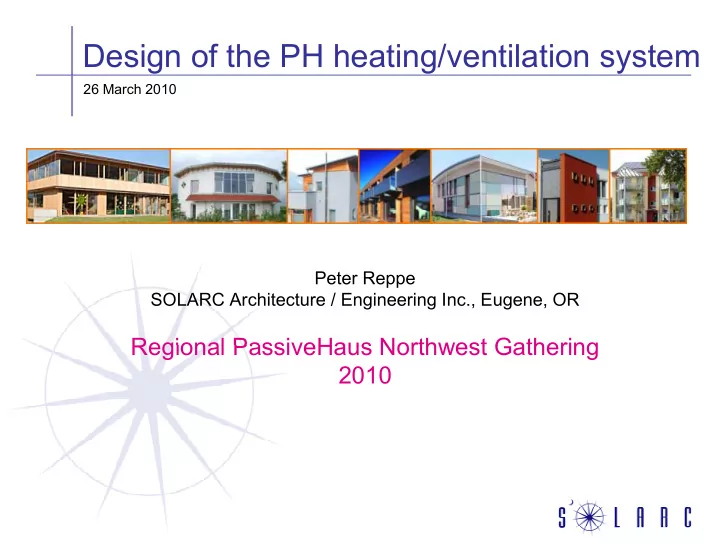

Design of the PH heating/ventilation system 26 March 2010 Peter Reppe Peter Reppe SOLARC Architecture / Engineering Inc., Eugene, OR Regional PassiveHaus Northwest Gathering Regional PassiveHaus Northwest Gathering 2010
Summary, Mechanical Systems in Passive Houses Houses 26 M 26 March 2010 h 2010 • Glossary for the non-engineer • Unique aspects of PH mechanical systems • System options / variations (esp. for NW y p ( p climate) • Interaction between mech system and other y uses (hot water, dryer, lights) • Ducts / diffusers (locations, layout, products) ( , y , p ) • Controls (how and why) • Integration of Renewables Integration of Renewables • Basics of equipment sizing
Glossary for the non-engineer 20,000 100.0% 18,000 90.0% 16,000 80.0% nt Load 14,000 70.0% erms 12,000 60.0% 26 March 2010 26 M h 2010 MBH or the Percent Plan 10,000 50.0% 8,000 40.0% 6,000 30.0% 4,000 20.0% 2,000 10.0% • Ventilation - 0.0% 0 20 40 60 80 100 120 OSA Temperature, F Input MBH Bin Hours Baseline Gas Use FEM-1 Gas Use % Input Plant • Peak heating/cooling load • Load vs. consumption • Supply-, return-, outside-, exhaust-air Supply , return , outside , exhaust air • OA economizer • Types of heating Equipment Equipment
Unique aspects of PH mechanical systems 26 M 26 March 2010 h 2010 • Low air flow rates • Variable speed fans • Low supply air speeds into space • Little/no temperature stratification in Little/no temperature stratification in bldg. • 100% outside air system 100% t id i t • Ultra-low flow-resistance ductwork
System Options in moderate Pacific Northwest Climate Climate 26 M 26 March 2010 h 2010 • Heat or energy recovery ventilator til t • Heating options: – Electric resistance (air / hydronic) – (Air-Source) Heat pump (S.S.) – Wood / Natural Gas (hydronic) Wood / Natural Gas (hydronic) – Solar (air / hydronic) • Cooling options: – Prevention 3 + passive cooling (+ waste “coolth”) – Earth tube – (Hydronic Coil) – (Air-Source) heat pump
Interaction w/ other systems 26 M 26 March 2010 h 2010 • Domestic hot water • Stove / Hood • Dryer • Lights Lights • Fridge • Other appliances, gadgets g g
Air transport and delivery 26 M 26 March 2010 h 2010 • Ducts • Diffusers, Return grilles • Transfers • Silencers Silencers • T&B
Controls 26 M 26 March 2010 h 2010 • KISS • Temperature • Supply Air flow rate • (Outside Air flow rate) (Outside Air flow rate)
Integration of Renewables 26 M 26 March 2010 h 2010 • Electric systems Electric systems –Photovoltaics –Micro-Hydro –Micro-Wind Micro-Wind • Solar Thermal –Hot Water –Air collectors Air collectors
Equipment sizing, basics 26 M 26 March 2010 h 2010 • Ventilation (V in cfm) Ventilation (V in cfm) –PHPP, “Ventilation“ tab or ASHRAE 62 • Heating (Q in Btu/hr) –PHPP, Heat Load tab, Q84 (+ ?? %) PHPP “Heat Load“ tab Q84 (+ ?? %) • Equipment sizing q p g –Coils: rated capacity in Btu/h or Watts –Air: Q = 1.085 x V (cfm) x ∆ T (°F) Ai Q 1 085 V ( f ) ∆ T (°F) –Hydronic: Q = 500 x GPM x ∆ T (°F) Hydronic: Q 500 x GPM x ∆ T ( F)
Questions… 26 M 26 March 2010 h 2010 The End (or the beginning?) beginning?)
Recommend
More recommend